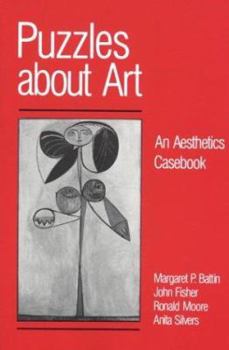Puzzles about Art: An Aesthetics Casebook
Select Format
Select Condition 
Book Overview
The first casebook for use in courses in aesthetics, Puzzles about Art provides more than 180 real and hypothetical cases that illustrate important principles and theories in the philosophy of art.... This description may be from another edition of this product.
Format:Paperback
Language:English
ISBN:0312003072
ISBN13:9780312003074
Release Date:March 1989
Publisher:Bedford Books
Length:226 Pages
Weight:0.78 lbs.
Dimensions:0.5" x 5.7" x 9.3"
Customer Reviews
4 ratings
excellent for teaching
Published by Thriftbooks.com User , 14 years ago
If you want to teach aesthetics in art to any age, this is the book for you. The individual puzzles are interesting for students to discuss.
A Casebook, not an Anthology or Expository Text
Published by Thriftbooks.com User , 15 years ago
"Puzzles about Art: An Aesthetics Casebook" is just that, a selection of puzzling cases which raise interesting questions about art and art theory. The book is organized into 6 chapters: Art and Artworks; Beauty, Ugliness and Aesthetic Experience; Meaning and Interpretation; Creativity and Fidelity; Art and Other Values; and Critical Judgment. Each chapter begins with a 10-page introduction and then provides another 10-25 pages of questions, problems, and case studies. The case studies, which are drawn from a wide variety of sources (some previously published and discussed, others not; some real, some fabricated) are the real contribution made by this collection. The questions and issues they raise are both timely and important to any study of aesthetics. A previous reviewer describes the book as a "welcome and refreshing departure from the standard approach," but while the book is certainly welcome and refreshing, it's less a departure from the usual literature than a helpful supplement to it (which is how I've used it in my college courses). It's certainly not a stand-alone text. If you don't know art theory, this collection of cases will not teach you much about it--and that's it's only real weakness, since it could have. The introductory discussions to each set of cases are generally well-written and interesting, but without adding much if any length to the text they could have done a better job of introducing and explaining the primary thinkers on each subject, rather than just offering a mostly topical overview to contextualize what follows. In other words, the authors of this otherwise fine text missed a chance (or at least, they didn't take full advantage of the chance) to educate their readers rather than just stimulate their thinking. Hopefully a second edition will correct that missed opportunity, for it would make the book infinitely more helpful to readers unfamiliar with our rich but complicated philosophy of art.
Versatile
Published by Thriftbooks.com User , 22 years ago
This was a thought provoking text, easily digestible and not intimidating. I found this book to be selectively useful with a wide range of students. My middle school students were stimulated by a selection of "puzzles" to decide art's validity and purpose. I plan to send this book to a college professor as well, knowing that the thought provoking segments will also be enticing for him to use in his class in Nice, France.
Puzzles provide exciting introduction to aesthetics.
Published by Thriftbooks.com User , 25 years ago
"Puzzles About Art" is a welcome and refreshing departure from the standard approach to philosophical aesthetics which can often make the novice shake her head and wonder how philosophical debates could be relevant to resolving issues in art. Following trends in comtemporary ethics, Battin uses both fictional and factual puzzle cases to introduce and highlight many of the problems which arise when making judgements concerning art. The puzzles are written in such a way that even the philosophically uninitiated can begin to take up and discuss the issues and to feel the tensions inherent in the puzzles.The puzzles cover a wide-range of aesthetic issues including the definition of art, interpretation, and conflicts between art and other values. Each section begins with a discussion of the main issues highlighted in the following cases and some of the ways in which philosophers have tried to resolve the issues presented. I came across this book while searching for a suitable resource to help introduce primary-aged students to philosophical aesthetics, but needed a more active approach that would capture the interest and curiousity of children. The puzzles are constructed in such a way that many can be stripped of their more advanced concepts and adapted for this age group, yet retain much of their force and intrigue.If you are interested in issues in aesthetics or in teaching aesthetics, it is definitely worth looking at this book!






